BMW cooling systems have been keeping repair technicians and enthusiasts busy for a long time. Cooling system issues almost seem like the Achilles heel for BMW vehicles as they are quite common. As far back as the E30, clogged radiators and blown coolant hoses were common.
Moving to the E36, the electric cooling fans were notorious for failing, resulting in overheating cars and owners. Even the venerable E46 had many cooling system weak points such as the common expansion tank leak and thermostat failures. With each new generation of vehicles, there are new and different problems to overcome.
BMWs are designed to be driven to the limit. This means the cooling system must operate under extreme conditions and still keep the engine running well within temperature specifications. Even though these systems are engineered and tested in Deutschland, they still sporadically suffer failures.
With BMW’s design, many aspects of the cooling system have been adapted to help lower emissions and fuel consumption. Lighter composite materials are an easy way for manufacturers to lower vehicle weight and increase fuel efficiency. This is the primary reason there are so many plastic components on modern BMWs.
Many cooling system components are made of light-weight plastics, which eventually degrade over time. Constant heat cycling flexes and eventually weakens many of these components. Add hot coolant and oil to the mix, and these parts really take a beating. Keep this in mind when removing cooling system components during repair work. Any seal ring that has been removed during the repair should be replaced or at least inspected to verify its integrity. Coolant outlet flanges on E90 engines commonly fall apart during removal as they reside in the hot cylinder head and are also exposed to oil leaks.
Engine oil has the nasty habit of swelling rubber seals when allowed to leak. Some of the most common oil leaks on newer BMWs are from the valve cover gaskets as well as the oil filter stand gasket. Unfortunately, because these components sit at the top of the engine, oil can leak over the entire front area of the engine. This lets engine oil seep into coolant outlet seals, coolant hose seals, and many other sensors and gaskets as well as the primary drive belt.
Most BMW technicians are aware of what damage the drive belt will do once it becomes degraded from oil contamination. Best case scenario is just a shredded drive belt. Worst case scenario is bent valves from the belt sucking into the crank seal and jumping the camshaft timing. Keep this in mind when replacing engine components from oil damage. And it’s necessary to fix the oil leak too, or the same failures will occur again.
BMW engine management systems monitor coolant temperature closely. Coolant temperature is one of the inputs used to help determine proper fuel/air mixture in BMW vehicles. The coolant temperature is basically the running temp of the entire engine other than the exhaust system. Coolant temperature is a critical piece of information used to determine proper engine running characteristics.
BMW coolant temperature sensors rarely fail. In cases where a temp sensor has failed, they commonly read at an extremely low temperature. Think –30 degrees F. This makes the vehicle run extremely rich, if it starts at all. Black smoke and strong gas odors from the tailpipe are the give-aways here.
In certain cases, if the vehicle has overheated, fault codes may be stored in the DME for Coolant Temperature Implausible. Using freeze frame data it’s usually possible to see how hot the cylinder head has gotten. As most BMW technicians know, these vehicles do not like to be overheated. Head gaskets go quickly when abused on BMWs.
Most modern BMWs are designed to efficiently operate between 176 degrees F and 220 degrees F (80-105 degrees C). An engine operating at too low a coolant temperature is not as fuel efficient. More fuel is required at lower temperatures to sustain a full combustion cycle.
One key design of the efficient dynamics system is to reach full operating temperature as quickly as possible. This allows for less fuel consumption as well as getting the catalytic converter to operating temperature quickly to further lower tailpipe emissions. Operating the engine at the highest temperature that is safe [for the engine] is an excellent way to increase fuel economy. A hot engine is a lean, fuel-efficient machine. Until it gets too hot.
In order to manage the engine coolant temperature, BMW employs many tactics to strictly control the coolant temperature. Depending on driving characteristics, the system may request a higher or lower temperature. Primarily when fuel economy is desired, a higher coolant temp will be requested. In high engine output mode, lower temps are generally requested by the engine. This helps to protect the engine and can also lower the temperature of incoming air through the engine, which can slightly increase power.
Since its introduction in the E90 generation, BMW began using electric coolant pumps on many models. The electric pump has many advantages over a standard drive belt run coolant pump. The most obvious advantage is lower drag on the engine from the accessory drive. This alone can slightly improve fuel economy.
On turbocharged vehicles, the electric coolant pump can continue to run after the vehicle has been parked and turned off. This is used to safely cool the turbochargers and residual oil in the turbo assembly. A blazing hot turbo can literally cook the oil in the turbo, causing coking, clogs, and many other issues. Hot turbochargers need to be cooled, otherwise damage can occur. The electric water pump makes it easy to safely cool them down.
With the use of electric coolant pumps, the engine management system is able to fine tune coolant flow through the engine. During the warm-up phase of engine running, the coolant pump may be slowed down or even completely turned off. This unsurprisingly will quickly raise the coolant temperature of the engine. Once the coolant is at a suitable temperature, the pump begins to circulate again. Scary, but this system does work well.
These electric coolant pumps aren’t without their own problems. These pumps do operate in a cramped, hot engine bay, and must have a waterproof electric motor that can run at multiple varying speeds. These pumps do eventually fail, commonly from coolant contamination or the electric motor failing.
The most common complaint from customers with a failed electric water pump is warning lights on the dash. If a problem is detected with the pump, the orange coolant warning light generally comes on. If the pump has failed completely, the red coolant warning light comes on the dash. This is the warning to pull over and turn off the engine.
FAULT CODES |
|
2F6C Exhaust gas flap, activation |
|
2AAF Fuel pump, plausibility |
|
2E81 Electrical coolant pump, speed deviation |
|
2E82 Electric coolant pump, cutoff |
|
2EFE Electric fan, activation |
In cases where the coolant pump has failed, the engine management system will try to save the vehicle from overheating. This includes turning off the air conditioning to lower radiator temperatures. The engine will even try to slow the vehicle and safely stop the engine from running in order to save itself from overheating. This is accomplished by locking the torque converter at low speed to initiate a stall. If the customer ignores the warning lights, they will notice a problem when the engine stalls out.
When diagnosing a BMW for almost any problem, it’s important to start with a full scan of the vehicle for faults. If the electric coolant pump has problems, there will be fault codes stored in the DME.
When diagnosing a failed water pump, inspecting the electrical connection to the pump should be one of your first steps. Always check for power and ground. Don’t make the rookie mistake of forgetting this important step in your diagnosis.
These pumps commonly fail from coolant contamination at the plug end of the pump. Once coolant reaches the electrical connector, the damage has probably been done to the pump. Coolant will quickly short circuit the electronics in the pump and destroy it. Close examination and cleaning of the electrical connector may be necessary after coolant pump replacement. It’s also wise to inspect the coolant pump for blockage or damage from foreign material. This is rare, but a small piece of plastic or other foreign material can jam the pump impeller, impeding flow.
Removal and replacement of the coolant pump is generally a straightforward procedure. The pump is located on the passenger side lower front corner of the engine block on most models. The coolant pump and thermostat assembly are assembled closely together in this location on many six-cylinder engines.
Accessibility of the pump during replacement can seem daunting as the pump is barely visible. If possible, it is recommended to remove the electric fan as a first step during pump replacement. This may not always be necessary, but the extra room given at the front of the engine can make a big difference in ease of removal. On models with oil coolers, fan removal may be more trouble than it’s worth as they can be time-consuming to safely remove.
If the coolant pump and thermostat have aluminum mounting bolts, always replace them once removed. These are one-time use fasteners and will break if re-used. If replacing the coolant pump, it’s wise to replace the thermostat assembly at the same time, particularly if it needs to be removed during coolant pump replacement.
The coolant hoses at the coolant pump/thermostat junction can be difficult to access. It’s necessary to remove the hose connections and thermostat assembly before fully accessing the coolant pump. Be careful not to lose or damage the securing clips on the coolant hoses after disconnecting them. They will fly across the shop or into the deep recesses of the engine bay, never to be seen again if you’re not careful.
Flexible drivers are the only way to access and successfully loosen the worm gear clamps that secure the additional coolant lines at the pump and thermostat. If you are repairing an xDrive coolant pump, access is even more limited, and it may be necessary to remove the underbody brace and paneling on the passenger side wheel well to fully access the coolant hose connections.
The thermostat plays a small but important role in the BMW cooling system. Its job is to help control the coolant temperature by limiting coolant flow through the engine during the warm-up phase. Once the engine is up to operating temperature, the thermostat is fully open.
BMW uses a standard thermostat design with the addition of a heater circuit integrated into the assembly. The heater is used to open the thermostat at a lower temperature, allowing for quicker warm-ups. The heater circuits are known to fail on these thermostats just like the old M54 thermostats. Faults are commonly stored in the DME as Thermostat Heater Circuit. In rare cases, the electrical connection seal at the thermostat can give out and begin wicking coolant through the engine harness. A failure like this can wreak havoc on vehicle electrical systems.
After any cooling system repairs are made to BMWs with electric coolant pumps, the system must be bled fully. BMW has included activations through the DME to run a bleeding procedure for the pump. This function runs the coolant pump at varying speeds to fully circulate coolant through the entire system. The bleeding procedure should be allowed to run for 5-10 minutes to complete fully.
It’s also necessary to have a battery maintainer on the vehicle during the bleeding procedure. Low battery voltage will terminate the bleeding procedure. Maintaining the battery voltage is a critical step on BMWs any time the ignition is left on for any amount of time.
BMW has also given us a trick to bleed the coolant system without the scanner if desired. Key on engine off, turn the fan to the lowest speed setting and set the temperature to max. After this step, press and hold the gas pedal to the floor for ten seconds. This will initiate the bleed procedure. The coolant bleed procedure works on most BMWs with electric coolant pumps installed.
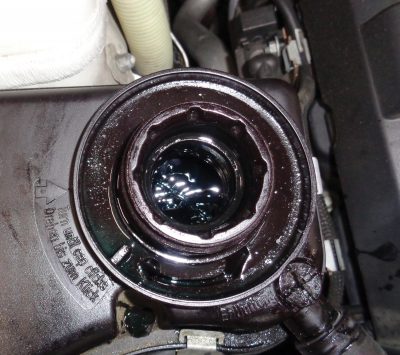
The coolant expansion tank continues to be a weak point on new BMWs. Splitting at the sides and leaking where the tank is bonded are the most common. Also be wary of the bleeding screw if equipped. These soft plastic screws do not like to be over-tightened. Keep in mind not to overfill these expansion tanks when filling. BMW uses level indicators on the tanks for a reason. Too much coolant in the expansion tank will force its way out when it expands. This alone can damage the expansion tank as well as the tank cap.
BMW coolant hoses and coolant lines have a habit of failing too. Typically, the plastic becomes brittle from heat and eventually blows apart under pressure. Be cautious when moving these coolant lines during other repairs. They can be extremely fragile. The expansion tank hard line that runs across the top of the radiator on many BMWs is notorious for breaking.
On The N62 V-8 engines, the valley between the cylinder heads contains a lot of coolant leak potential. There are small coolant return lines that leak. The valley pan gasket can leak, as can the large coolant transfer pipe running to the water pump. Get out your pressure tester and inspection mirror here when searching for coolant leaks. On turbocharged engines such as the N55, the coolant feed lines for the turbochargers are known to eventually degrade from heat. Once these fail, they can be a bear to replace.
The radiator and electric fan play a critical role in the cooling system. Without a way to exchange heat out of the engine during normal use, engine damage would rapidly occur. The radiator and fan setup on modern BMWs are fairly reliable. Not many issues occur here except from impact damage and occasional radiator leakage from end tanks.
Remember, these cooling systems are always under pressure when running and cooling the engine. Do not open a hot expansion tank cap quickly or remove coolant lines when the system is under pressure. Scalding hot coolant can and will burn! Always let the system cool down to safe temperatures before beginning repairs.
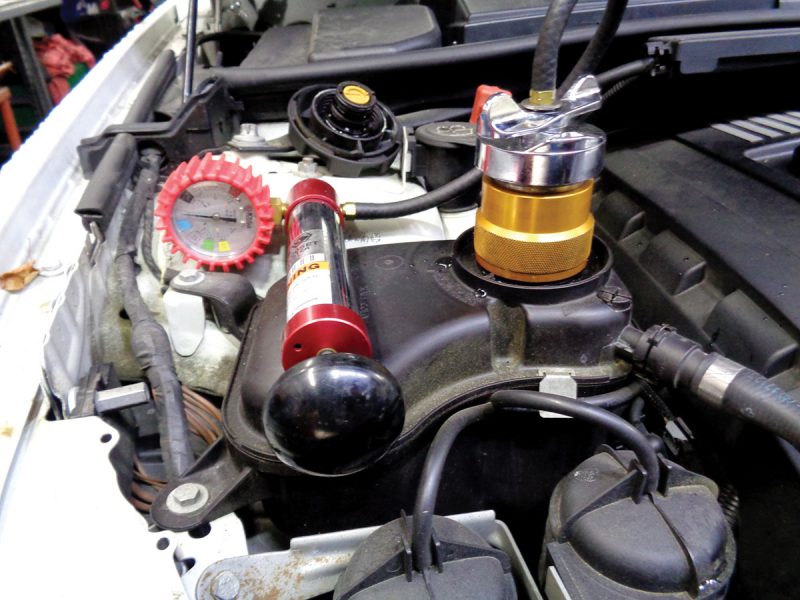

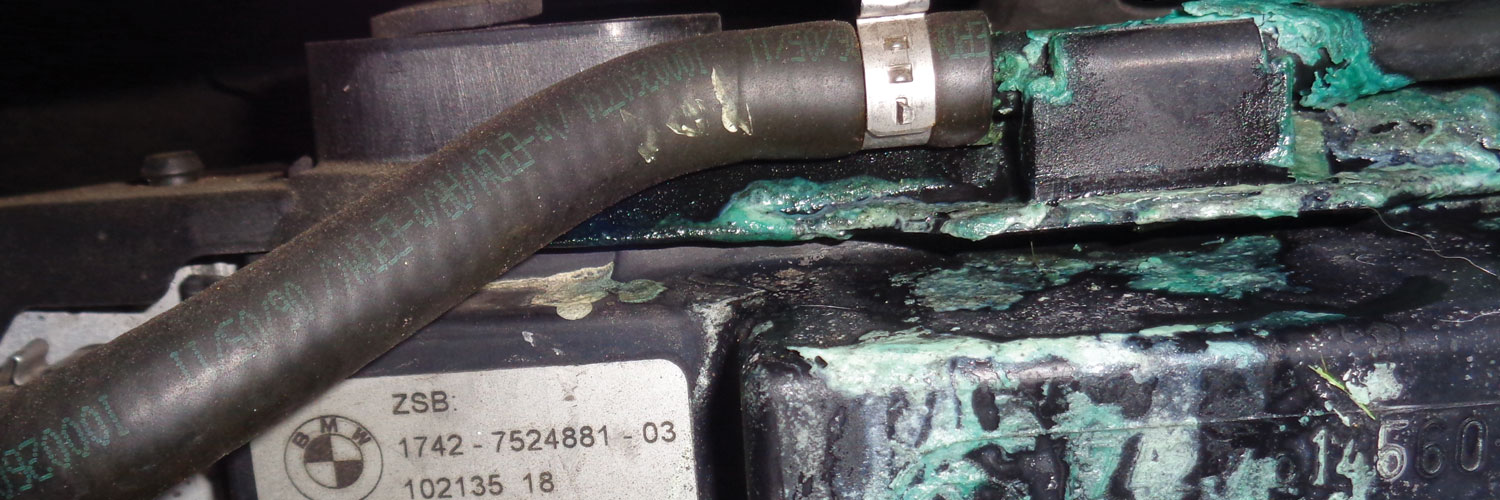

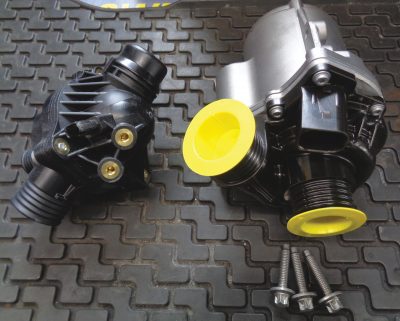
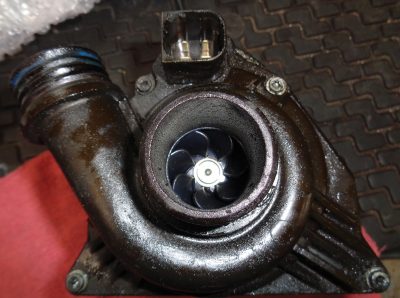
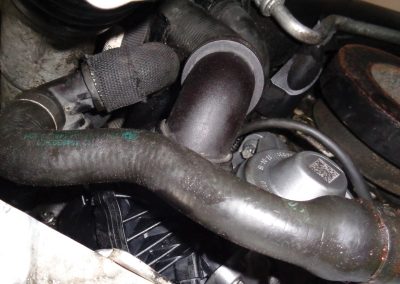

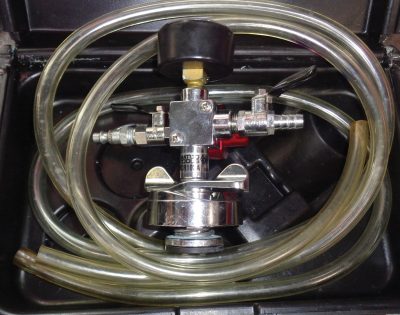
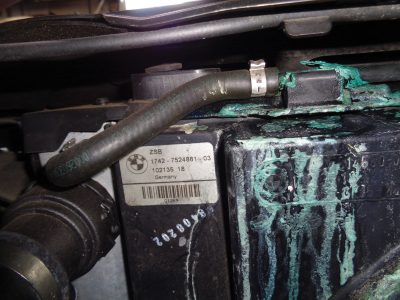
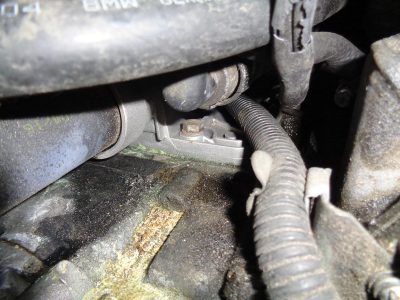



0 Comments